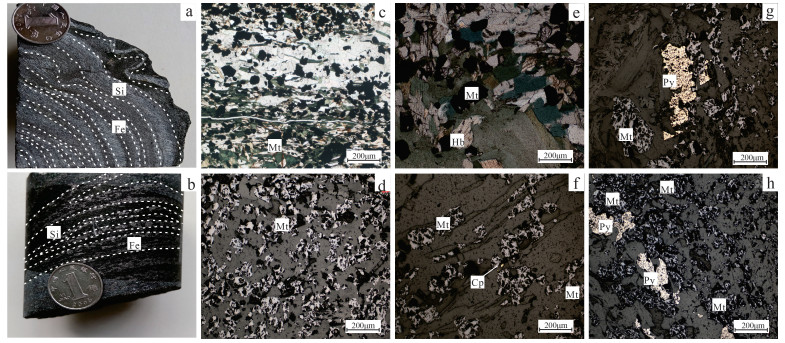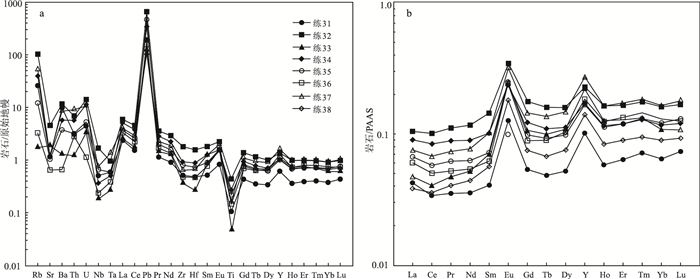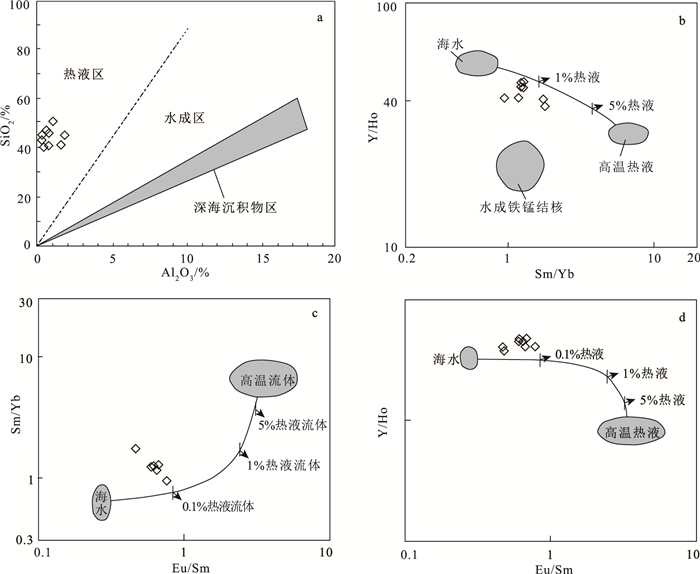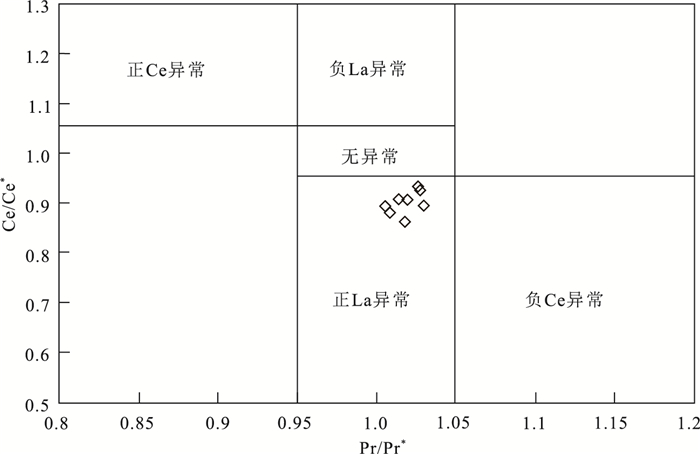Geochemical characteristics and genetic analysis of BIF iron deposit background of Xincai iron deposit in He'nan Province
-
摘要:
新蔡铁矿床位于华北克拉通南缘舞阳-霍邱铁矿成矿带中部, 矿体赋存于新太古代太华岩群变质岩系中。铁矿体主要呈层状、似层状, 局部为透镜状。矿石构造主要为条带状, 少量浸染状及块状。矿石主要由TFe2O3和SiO2组成, 其次为MgO和CaO, Al2O3及其他如Na2O、K2O、P2O5、TiO2、MnO含量大多小于0.1%。微量及稀土元素分析结果显示, 大离子亲石元素Sr和高场强元素Nb、Ta、Zr、Hf、Ti明显亏损, 此外Rb、U、La、Pb、Eu元素具正异常, Ti/V值平均24.13, 稀土元素总量较低, 平均为12.8×10-6。经PAAS标准化后, 铁矿石均表现为重稀土元素相对轻稀土元素富集((La/Yb)PAAS=0.43~0.79, 平均值0.55), 具有明显的La正异常(La/LaPAAS*平均值1.15)、Eu正异常(Eu/Eu*平均值2.88)和Y异常(Y/YPAAS*平均值1.68), 微弱的Ce负异常(Ce/CePAAS*平均值0.90)。较高的Y/Ho值(平均值44)说明含铁建造形成于相对缺氧的古海洋环境, 成矿物质主要来源于与海底火山活动相关的高温热液和海水的混合溶液。对矿体围岩斜长角闪岩原岩恢复及构造环境判别结果显示, 斜长角闪岩原岩为弧后盆地玄武岩, 代表其形成于弧后盆地的构造环境, 这也基本代表了本区含铁建造沉积时的构造环境。综合分析认为, 新蔡铁矿属于与弧后盆地火山活动密切相关的Algoma型BIF。
Abstract:The Xincai iron deposit is located in the middle part of the Wuyang-Huoqiu iron ore belt on the southern margin of the North China Craton.The ore body is hosted in the Late Archean Taihua Group metamorphic rock series.The iron ore body is mainly lamellar and partially lenticular.The ore structure is mainly banded, with a small amount of disseminated and massive ores.iron ore is mainly composed of TFe2O3 and SiO2, followed by MgO and CaO, and Al2O3 and others such as Na2O, K2O, P2O5, TiO2 and MnO are mostly less than 0.1%。Trace and rare earth element analytical results show that large ionic lithophile element such as Sr, high field strength elements such as Nb, Ta, Zr, Hf and Ti are significantly depleted, in addition, Rb, U, La, Pb, Eu elements are abnormal, and the average Ti/V ratio is 24.13, the total amount of rare earth elements is relatively low, and the average ∑REE is 12.8×10-6.After being standardized by PAAS, iron ore shows enrichment in light rare earth elements ((La/Yb) PAAS=0.43~0.79, average 0.55), with obvious La positive anomaly (La/LaPAAS* average 1.15), Eu positive anomalies (Eu/Eu* average 2.88), Y abnormalities (Y/YPAAS* average 1.68), and weak Ce negative anomalies (Ce/CePAAS* average 0.90).A relatively high Y/Ho value (average of 44) indicates that iron-bearing formation was formed in a relatively hypoxic palaeo-marine environment, and the ore-forming materials were mainly derived from the mixing of high-temperature hydrothermal fluids and seawater associated with volcanic activity on the sea floor.The results for the ore-bearing amphibolite analysis and the tectonic setting for the formation of the orebodies show that the protolith of amphibolite should be a post-arc basin basalt, which represents the tectonic setting of the amphibolite formed in the back-arc basin.The tectonic environment of the amphibolite also basically represents the tectonic environment when the iron-bearing formation was deposited in this area。According to the comprehensive analysis, Xincai iron mine belongs to Algoma type BIF closely related to volcanic activities in the back-arc basin.
-
Keywords:
- strip iron construction /
- magnetite /
- genesis of deposit /
- Xincai, He'nan Province
-
前寒武纪条带状铁建造(banded iron formations,简称BIFs)一般指铁含量大于15%,具富铁(以磁铁矿或赤铁矿为主)和富硅(以石英为主)或碳酸盐物质条带(条纹或细纹)状构造特征的化学沉积岩[1-4]。主要形成于前寒武纪、特别是早前寒武纪稳定克拉通绿岩带内,可以反映当时的地质环境和演化特征[2]。国际上主要依据BIFs形成时的构造环境和岩石组合将BIFs分为2类:一类是形成于与火山作用密切相关的岛弧、弧后盆地中的Algoma型;一类是形成于被动大陆边缘或稳定克拉通盆地内的Superior型[5]。目前全球BIFs多发育于南美、北美、格陵兰、加拿大、南非、澳大利亚、俄罗斯、乌克兰、中国、印度等地的古老克拉通内[6-7]。中国对BIFs的研究始于20世纪50年代[8],大量学者通过研究不同地区产出的BIFs发现,中国BIFs集中发育在华北克拉通内,诸如鞍山—本溪、冀东—密云、鲁西、五台—吕梁、内蒙固阳、河南舞阳—新蔡、安徽霍邱等地区;太古宙—古元古代早期均有产出,新太古代晚期(2.5 Ga)为发育高峰期[9];铁矿石以条带状、条带浸染状的贫铁矿石为主,富矿很少且多埋藏深度大,铁矿床多属Algoma型[1, 10]。
舞阳-霍邱铁矿成矿带是华北克拉通南缘最重要的BIF铁矿赋存带。目前已查明舞阳地区铁矿资源量约4.5×108 t,新蔡地区约5.6×108 t,霍邱地区约8.8×108 t。对于霍邱铁矿,多数学者认为属Superior型铁矿床[11-12],也有学者认为其属于Algoma与Superior之间的过渡类型[13-14]。舞阳地区铁山庙式BIF成因类型亦有争议,部分学者发现铁山庙式铁矿矿石中含大量辉石,含铁岩系围岩主要为碳酸盐岩-碎屑岩建造,而非火山岩建造,与鞍山式铁矿有明显差异,可能属一种特殊的BIF[15]。也有学者认为铁山庙式BIF与霍邱BIF同属Superior型[16]。新蔡铁矿区位于舞阳-霍邱成矿带的中部,在构造格局上起到承上启下的作用,是该成矿带的重要组成部分。目前新蔡铁矿的研究成果较少,有学者将新蔡BIF的沉积年龄限制在2.5~2.7 Ga, 微量元素特征类似于其他BIFs[17],且形成于新太古代的弧后盆地构造环境[18]。查明新蔡铁矿的成因,对于理解舞阳-霍邱成矿带上其他地区铁矿床的成因具有参考作用。因此,本文选取新蔡地区典型矿床为研究对象,通过对矿石系统的主量和微量元素分析,探讨新蔡地区铁矿床的成矿物质来源、沉积环境及矿床成因。
1. 区域地质背景
新蔡铁矿区位于华北克拉通南缘,大地构造位置为华北克拉通南缘三门峡-新蔡隆起带的东段(图 1),黑沟-羊册断裂北侧,河南地层综合分区华北平原分区豫东小区,新华夏系华北沉降带的南缘新蔡-息县褶皱隆起带上。区域上,自河南鲁山—舞阳地区(太华岩群)直到安徽的霍邱地区(霍邱群),均发育前寒武纪的含铁建造岩系,地层具有典型的双层结构。
研究区基底为太华岩群含铁建造变质岩系,盖层为震旦系、中生界侏罗系、白垩系、新生界古近系、新近系、第四系。含矿地层主要为太华岩群铁山岭组,岩性主要为斜长角闪片麻岩、黑云斜长片麻岩、黑云石英片岩、二云石英岩、含铁铝榴石斜长角闪片麻岩、含磁铁石英岩、含磁铁角闪石英岩、含矿黑云石英岩、黑云母透闪阳起石岩、黑云母石榴子石英岩、斜长角闪岩、透辉斜长角闪岩等。练村铁矿含铁建造中的变质岩,多出现角闪石-石榴子石矿物组合,部分含铁层段岩石中石榴子石较发育,变质程度普遍达角闪岩相。
2. 典型矿床地质特征
练村铁矿床位于河南省新蔡县城东南120°方向20 km的顿岗乡和练村镇一带,行政隶属新蔡县练村镇。矿区东西长约10.93 km,南北宽2.78~3.72 km(西部约2.78 km、中部约3.24 km、东部约3.72 km),面积34.69 km2。练村铁矿床是新蔡地区已发现的规模最大的铁矿床。
2.1 矿体特征
矿体主要赋存于新太古界太华岩群铁山岭组含铁建造中,分布范围东西长约8600 m,南北宽200~1600 m,自东向西可划分为6个相对独立的矿段。区内铁山岭组岩石组合简单,主要由斜长角闪片麻岩、黑云母斜长片麻岩、变粒岩、角闪石岩、透辉石角闪石岩、石榴子石角闪片麻岩、条带状磁铁斜长角闪片麻岩、条带状磁铁角闪石英岩、条带状磁铁石英岩、磁铁石英片岩、黑云石英片岩、花岗质混合岩、少量长石石英质变粒岩等组成。其中,磁铁矿主要产在角闪石英岩与斜长角闪片麻岩、黑云母石英片岩中。据钻孔资料显示,埋深最浅624 m,最深862 m。其中Ⅰ号、Ⅱ号、Ⅲ号矿段矿体倾向北西,Ⅳ号、Ⅴ号、Ⅵ号矿段矿体倾向南西(图 2)。
矿体主要受地层控制,产状与围岩基本一致,走向北东东—南西西向,倾角3°~10°,矿体形态一般呈层状、似层状。其中规模最大的主矿体Ⅰ-3矿体走向控制长度约2.2 km,倾向延伸大于1600 m,未完全控制边界。矿体顶底板主要为黑云斜长片麻岩、斜长角闪片麻岩、含石榴子石角闪岩,局部为花岗岩脉。顶底板与矿层之间界线不清晰。各矿段岩石组合也不同,但整体上具有可对比性。主要岩性组合有:①斜长角闪岩、斜长角闪片麻岩、黑云斜长片麻岩夹黑云斜长变粒岩;②含磁铁矿角闪石英岩、条带状磁铁石英岩(D矿组),厚度大于60 m;③含石榴子石斜长角闪片麻岩夹黑云斜长片麻岩、变粒岩;④含石榴磁铁角闪石英岩、含磁铁黑云母石英片岩夹石榴角闪斜长片麻岩(C矿组),厚度大于350 m,未见底, 其中C矿组铁矿层与含石榴子石类岩石普遍关系密切。
2.2 岩(矿)石特征
练村矿床矿石类型主要为磁铁角闪石英岩,其次为磁铁黑云石英(片)岩、含石榴磁铁角闪石英岩。矿石矿物主要为磁铁矿,局部可见赤铁矿,另有星点状分布的黄铁矿、黄铜矿。脉石矿物主要为石英,其次为角闪石、黑云母、石榴子石、阳起石、透闪石等。矿石手标本及镜下照片见图版Ⅰ。
磁铁角闪石英岩:矿石呈灰色,柱粒状变晶结构,变余层理构造,灰白相间条带发育。石英含量50%~75%,多为他形粒状,少为似砂状,呈定向分布。角闪石含量20%~30%,为半自形—他形柱状,多呈定向分布,部分填隙状分布。磁铁矿含量15%~30%,呈半自形—他形粒状,大小一般0.01~0.1 mm,部分0.1~0.2 mm,少量0.2~0.4 mm,呈定向分布。集合体与透明矿物相间排列,构成变余层理构造。另含少量斜长石、方解石、绿泥石、黑云母、黄铁矿、黄铜矿等。
磁铁黑云石英(片)岩:矿石呈深灰色,含鳞片粒状变晶结构,变余层理构造,灰白相间条带发育。石英含量50%~75%,为他形粒状,大小0.1~0.2 mm,部分0.2~0.3 mm,少量大于0.3 mm,主要呈镶嵌状定向分布,构成矿石主体部分。黑云母含量10%~15%,为片状,直径0.1~0.3 mm,部分0.5~1.5 mm,定向分布,部分集合体似条痕、条纹状定向分布,局部被绿泥石交代。磁铁矿含量15%~25%,呈半自形—他形粒状,大小0.01~0.1 mm,部分0.1~0.2 mm,少量0.2~0.4 mm,呈定向分布。另含少量斜长石、角闪石、石榴子石等。
研究区C矿组磁铁矿层及其夹层中普遍发育石榴子石。薄片鉴定显示,石榴子石一般呈半自形粒状,大小1~5 mm,少量0.5~1 mm,星散状分布,可见网状裂隙,沿裂隙有绿泥石、方解石及石英交代,属铁铝榴石。
研究区矿石镜下鉴定均可见轻微碎裂,岩石内部可见裂隙,沿裂隙有方解石充填交代。变质相为绿片岩相—角闪岩相。
3. 矿床地球化学特征
选取练村铁矿床8件矿石样品进行全岩主量、微量和稀土元素测试。矿石主量和微量元素在中国地质科学院国家地质实验测试中心完成,主量元素采用Phillips PW 2404型X荧光光谱仪分析测试,RSD小于2%~3%,微量及稀土元素分析利用酸溶法制备样品,在Finnigan Element型ICP-MS下进行测试,RSD小于2.5%。测试结果见表 1。
表 1 练村铁矿矿石主量、微量和稀土元素组成及相关参数Table 1. Composition and related parameters of major, trace and rare earth elements in Liancun iron ore岩性 磁铁角闪石英岩 样品号 练31 练32 练33 练34 练35 练36 练37 练38 TFe2O3 47.79 40.77 47.92 47.69 49.88 45.42 42.76 53.13 SiO2 45.47 45.28 43.26 41.31 40.93 47.23 46.27 40.43 Al2O3 0.39 1.87 0.33 1.64 0.80 0.66 0.76 0.48 MgO 0.46 1.24 1.88 1.88 2.15 1.23 1.77 1.42 CaO 1.32 2.44 2.18 3.06 1.91 1.77 1.38 2.91 Na2O 0.078 0.064 0.037 0.051 0.026 0.050 0.062 0.020 K2O 0.18 0.88 0.034 0.46 0.19 0.062 0.36 0.043 P2O5 0.055 0.14 0.19 0.11 0.10 0.10 0.12 0.089 TiO2 0.025 0.14 0.018 0.075 0.072 0.042 0.038 0.032 MnO 0.076 0.063 0.093 0.13 0.22 0.066 0.092 0.19 Li 6.65 3.52 0.57 5.99 0.82 1.38 8.83 0.24 Be 0.36 0.81 0.11 0.22 0.30 0.04 0.56 0.12 P 362 670 974 488 531 520 899 485 Sc 0.44 1.68 0.31 0.98 0.99 0.65 1.04 0.45 Ti 138 571 65.5 357 284 192 220 123 V 8.65 19.10 4.26 12.80 10.30 6.42 8.09 6.38 Cr 5.32 10.50 3.83 5.13 24.00 4.52 8.35 3.73 Mn 752 445 690 901 1620 453 895 1330 Co 4.95 5.32 4.45 4.95 4.68 4.71 5.31 3.63 Ni 3.38 6.77 3.21 5.14 4.54 2.62 5.17 3.15 Cu 1.77 6.56 1.48 11.80 1.59 1.01 1.31 0.63 Zn 10.80 11.80 9.55 25.80 15.20 15.30 15.30 12.00 Ga 1.26 3.12 0.84 3.45 1.70 3.87 1.97 1.36 Ge 3.18 4.66 1.72 2.45 3.20 1.59 3.60 3.05 Rb 16.50 65.2 1.15 25.3 7.77 2.10 34.6 1.55 Sr 24.5 95.9 41.7 24.8 22.1 13.8 26.5 73.4 Y 2.80 6.22 6.09 4.71 4.57 4.97 7.47 3.80 Zr 5.73 20.0 4.27 10.4 8.94 5.36 7.54 2.93 Nb 0.36 1.21 0.14 0.26 0.47 0.17 0.55 0.28 Mo 0.13 0.16 0.10 0.16 0.66 0.18 0.29 0.09 Sn 0.21 0.22 0.09 0.19 0.17 0.12 0.31 0.11 Cs 3.25 5.21 0.12 2.19 0.27 0.27 3.06 0.10 Ba 68.6 82.9 9.34 40.0 26.2 4.66 62.7 7.94 Hf 0.15 0.49 0.09 0.27 0.23 0.14 0.22 0.08 Ta 0.02 0.04 0.01 0.02 0.02 0.02 0.06 0.02 Pb 1.52 5.23 1.05 2.68 3.68 1.24 0.88 1.39 Th 0.26 0.58 0.11 0.49 0.27 0.24 0.81 0.16 U 0.09 0.30 0.07 0.24 0.11 0.02 0.24 0.06 Sm/Yb 1.24 1.76 1.27 1.72 1.17 0.94 1.22 1.24 Eu/Sm 0.61 0.47 0.67 0.47 0.66 0.78 0.60 0.63 Sr/Ba 0.36 1.16 4.46 0.62 0.84 2.96 0.42 9.24 Ti/V 15.95 29.90 15.38 27.89 27.57 29.91 27.19 19.28 La 1.65 4.08 1.84 3.49 2.56 2.30 2.93 1.46 Ce 2.76 8.03 3.30 6.67 4.58 3.99 5.46 2.83 Pr 0.32 0.99 0.43 0.79 0.55 0.46 0.66 0.36 Nd 1.23 3.94 1.80 3.04 2.12 1.82 2.66 1.49 Sm 0.23 0.80 0.40 0.57 0.40 0.34 0.58 0.31 Eu 0.14 0.38 0.27 0.26 0.26 0.27 0.35 0.20 Gd 0.26 0.83 0.51 0.57 0.46 0.41 0.69 0.35 Tb 0.04 0.12 0.08 0.08 0.07 0.07 0.11 0.05 Dy 0.25 0.74 0.52 0.52 0.46 0.48 0.70 0.35 Y 2.8 6.22 6.09 4.71 4.57 4.97 7.47 3.8 Ho 0.06 0.16 0.13 0.12 0.11 0.12 0.16 0.08 Er 0.19 0.48 0.37 0.34 0.34 0.38 0.50 0.26 Tm 0.03 0.07 0.05 0.05 0.05 0.06 0.08 0.04 Yb 0.19 0.46 0.31 0.33 0.34 0.37 0.47 0.25 Lu 0.03 0.07 0.05 0.05 0.06 0.05 0.08 0.04 ΣREE 7.36 21.15 10.06 16.88 12.36 11.13 15.42 8.07 LREE 6.33 18.22 8.03 14.81 10.47 9.18 12.64 6.64 HREE 1.04 2.93 2.03 2.07 1.89 1.95 2.78 1.42 LREE/HREE 6.10 6.22 3.96 7.17 5.54 4.71 4.54 4.67 (La/Yb)PAAS 0.65 0.66 0.43 0.79 0.55 0.46 0.46 0.43 Eu/EuPAAS* 2.93 2.34 3.04 2.33 3.10 3.47 2.80 3.03 Ce/CePAAS* 0.88 0.92 0.86 0.93 0.89 0.89 0.90 0.91 La/LaPAAS* 1.24 1.05 1.26 1.04 1.11 1.22 1.13 1.16 Y/YPAAS* 1.84 1.43 1.88 1.53 1.61 1.63 1.76 1.77 Pr/PrPAAS* 1.01 1.03 1.02 1.03 1.03 1.01 1.02 1.01 Y/Ho 47 38 48 41 41 41 46 46 注:La/LaPAAS* = LaPAAS(3×PrPASS-2×NdPASS);Ce/CePAAS*=2CePAAS/(LaPAAS+PrPAAS); Pr/Pr* PAAS =2Pr PAAS /(Ce PAAS +Nd PAAS); Eu/EuPAAS*=Eu PAAS /(0.67Sm PAAS +0.33Tb PAAS); Y/Y* PAAS =2Y PAAS /(Dy PAAS +Ho PAAS); 标准化数据据参考文献[21-22];主量元素含量单位为%, 微量和稀土元素含量单位为10-6 3.1 主量元素
样品分析结果(表 1)表明,矿石样品中SiO2含量在40.43%~47.23%之间,平均43.77%;TFe2O3含量在40.77%~53.13%之间,平均46.92%;Al2O3含量在0.33%~1.87%之间,平均0.87%(需要说明的是,本次8件矿石样品中有6件样品Al2O3含量小于0.8%,只有2件样品Al2O3含量大于1.5%);MgO含量在0.46%~2.15%之间,平均1.51%;CaO含量在1.32%~3.06%之间,平均2.12%;其他,如Na2O、K2O、P2O5、TiO2、MnO含量大多小于0.1%。研究区磁铁矿石中Al2O3、K2O、Na2O、TiO2、MnO、MgO等主量元素含量均很低,指示其具有海洋化学沉积物的特征,个别样品含量偏高,表明可能有少量陆源物质参与。
在矿石主量元素划分三角图(图 3)中,8件矿石样品全部投影在世界条带状铁矿石分布范围。
![]() 图 3 练村铁矿区矿石主量元素划分三角图(据参考文献[20]修改,图中阴影部分表示世界BIF铁矿分布区)Figure 3. Triangulation diagrams of ore main elements in Liancun iron deposit
图 3 练村铁矿区矿石主量元素划分三角图(据参考文献[20]修改,图中阴影部分表示世界BIF铁矿分布区)Figure 3. Triangulation diagrams of ore main elements in Liancun iron deposit3.2 微量元素
微量元素测试结果(表 1)及原始地幔标准化蛛网图(图 4-a)显示,大离子亲石元素Sr和高场强元素Nb、Ta、Zr、Hf、Ti明显亏损,此外Rb、U、La、Pb、Eu元素正异常。微量元素中Ti/V值常用来区分成矿物质来源和条带状铁矿的成因类型[20],一般认为铁质页岩的Ti/V值在1.33~10.90之间,火山建造的Ti/V值为13~85。练村铁矿8件矿石样品的Ti/V值在15.38~29.91之间,平均24.13,与火山建造一致。Sr/Ba值也常被作为判断成矿物质来源的参数。
一般认为,火山岩和海相沉积物的Sr/Ba值大于1,陆源沉积物的Sr/Ba值小于1[20],练村铁矿铁矿石的Sr/Ba值在0.32~9.64之间,平均2.51。8件矿石样品中4件样品的Sr/Ba值大于1, 另4件样品的Sr/Ba值小于1。结合其他参数,认为练村铁矿成矿主要与火山作用有关,但可能有少量陆源物质参与。
矿石稀土元素总量较低(表 1),∑REE在7.36×10-6~21.15×10-6之间,平均12.8×10-6。经PAAS标准化后,练村铁矿的稀土元素具有较一致的配分型式(图 4-b)。均表现为重稀土元素相对轻稀土元素富集((La/Yb)PAAS=0.43~0.79,平均0.55),具有明显的La正异常(La/LaPAAS*=1.04~1.26,平均1.15)、强烈的正Eu异常(Eu/EuPAAS*=2.33~3.47, 平均2.88)和Y异常(Y/YPAAS*=1.43~1.88,平均1.68),以及微弱的负Ce异常(Ce/CePAAS*=0.86~0.93,平均0.90)。Y/Ho值较高(Y/Ho=38~48,平均44),显示了与海水的亲缘性。以上稀土元素特征与华北克拉通内其他BIF铁矿稀土元素特征,除在部分元素异常强度上存在差别外,其他特征基本一致。
4. 讨论
4.1 成矿物质来源
国内外关于BIF硅铁建造中硅、铁物质来源一直存在争议。目前大多数学者倾向于硅、铁质主要来自于洋脊的海底高温热液与海水一定程度的混合,少部分来自陆壳岩石的风化[23-26];少数学者认为硅、铁质主要来源于基性陆壳岩石的风化[27-28]。根据矿石中稳定的Ge/Si值,认为硅、铁质具有不同来源,铁质主要来源于海底热液,而硅质主要来源于陆壳岩石的风化[29]。
Al2O3-SiO2判别图解主要用于判别铁-锰岩石的起源[30]。在Al2O3-SiO2判别图解(图 5-a)中, 练村铁矿石样品均落入热液区,暗示研究区BIF成矿物质沉积时与海底热液活动有关,热流体可能提供了硅、铁质。
稀土元素在BIFs的沉积过程中分馏极小,因此,可以有效地示踪硅铁建造的物质来源及沉积环境[31]。此外,由于稀土元素系统的封闭性和很低的水岩反应速率,较好地说明了硅铁建造中的稀土元素并不受成岩作用及成岩后的区域和接触变质作用影响[23]。
现代海水的稀土元素配分模式表现为轻稀土元素相对亏损、重稀土元素相对富集,La和Y正异常和Ce负异常[32-33]。练村铁矿石的稀土元素配分曲线显示,轻稀土元素相对亏损、重稀土元素相对富集,具有明显的La(La/LaPAAS*=1.04~1.26,平均1.15)和Y(Y/YPAAS*=1.43~1.88,平均1.68)正异常,微弱的Ce(Ce/CePAAS*=0.86~0.93,平均0.90)负异常,其特征与现代海水的稀土元素配分模式相符,暗示海水可能参与了含铁建造的形成。此外,Y/Ho值也常被作为判断海水或非海相沉积的有效指标。研究表明,热液流体Y/Ho值为26~28,陆相岩石和球粒陨石的Y/Ho值恒为26,海水的Y/Ho值为43~80,并随海水深度的增加而减小[32-35]。练村铁矿石的Y/Ho=38~48,平均44,暗示了练村铁建造形成过程中与海水的亲缘性。
Eu的正异常是海底高温热液的典型特征[36],无论是Algoma型还是Superior型BIFs均具有明显的正Eu异常(1.33~6.5)[11, 37-38],指示了海底高温热液沉积成因。正Eu异常的强弱反映了BIFs形成环境的氧化还原状况,热液组分越多,形成环境越还原,正Eu异常越明显,反之亦然[3]。有学者通过研究提出,与火山作用关系密切的Algoma型BIF的Eu/Eu*值大于1.8,而距离火山口较远的Superior型BIF的Eu/Eu*值小于1.8[38]。练村铁矿矿石样品Eu/Eu*=2.33~3.47,平均2.88,与Algoma型BIF的Eu异常特征一致,暗示有较多的高温热液流体参与了BIF的形成。
综上所述,练村铁建造稀土元素配分特征表明,其沉积过程主要与海水与海底高温热液相关,其成矿物质来源于海水与海底高温热液流体的混合溶液。针对如何判断海水与热液的贡献度大小,Sm/Yb-Y/Ho、Eu/Sm-Sm/Yb、Eu/Sm-Y/Ho组合图解用以判别海水与高温热液的混合比例大小[39]。通过对练村铁矿石样品投至Sm/Yb-Y/Ho、Eu/Sm-Sm/Yb、Eu/Sm-Y/Ho判别图解(图 5-b、c、d)中,可以看出区内矿石大多落于0.1%热液附近,且多数小于0.1%热液。结合前述分析结果,由此判断研究区铁建造成矿物质主要来源于海水与高温热液的混合溶液,其中海水的贡献略大于热液。这与目前前寒武纪BIFs成矿物质来源的主流认识一致。
4.2 沉积环境
在自然界中,Ce通常呈稳定的+3价态,但在氧化条件下,Ce+3会被氧化成Ce+4,然而Ce+4容易发生水解而被水体中悬浮颗粒强烈吸收影响稀土元素配分型式呈现出负Ce异常特征,因此,Ce异常被用来判断古海洋的氧化还原环境[40]。有学者提出用常规算法计算Ce异常,其负Ce异常的出现可能与La的正异常有关;因此,用常规算法下的Ce异常和Pr异常共同限定并判别真正的Ce异常,建立了Pr/Pr*-Ce/Ce*图解[41]。研究区8件磁铁矿石样品在Pr/Pr*-Ce/Ce*判别图解(图 6)上全部落入正La异常区,缺乏负Ce异常,暗示研究区含铁建造沉积期间古海洋整体处于缺氧环境。
![]() 图 6 练村铁矿石Pr/Pr*-Ce/Ce*异常判别图解(底图据参考文献[41])Figure 6. Pr/Pr* versus Ce/Ce* discrimination diagram of Liancun iron ores
图 6 练村铁矿石Pr/Pr*-Ce/Ce*异常判别图解(底图据参考文献[41])Figure 6. Pr/Pr* versus Ce/Ce* discrimination diagram of Liancun iron ores4.3 矿床成因类型
研究表明,无论是Algoma型还是Superior型BIFs,都是由地球早期的海底火山热液喷气作用形成的,属于同一成矿系统,差异主要是形成的构造背景不同。在某些有利环境和条件下,二者可密切共生,空间上相互过渡(表 2)[11]。相对Superior型BIFs而言,Algoma型BIFs与火山活动关系更密切,距离同期火山活动中心更近,多形成于深水盆地,环境更还原,Superior型BIF与此相反[11]。
表 2 Algoma型和Superior型BIF铁矿类型判别[19]Table 2. The BIFs contrast of Algoma and Superior types判别标志 Algoma型 Superior型 形成时代 中新太古代为主,2.8~2.5 Ga为高峰期 古元古代为主,2.5~1.8 Ga为高峰期 含铁建造类型 与超基性、基性火山岩-火山沉积岩相关 与碎屑岩-碳酸盐岩相关 构造环境 岛弧、弧后盆地或扩张大洋中脊附近 被动大陆边缘,大陆架浅海环境,克拉通内部盆地 矿物相 主要为磁铁矿相 具有明显的相分带,可见磁铁矿、碳酸盐和赤铁矿相 变质相 绿片岩相—角闪岩相,混合岩化较强 一般为绿片岩相变,混合岩化不明显 练村铁矿含铁建造赋存于新太古界太华岩群变质岩系中。含铁建造主要岩性组合为斜长角闪岩(片麻岩)、石榴子石斜长角闪岩、黑云斜长片麻岩、云母石英片岩、条带状磁铁(角闪)石英岩等,原岩恢复结果表明,角闪岩类原岩为玄武岩类火山岩。片麻岩类原岩主要为粘土质杂砂岩,石英岩类主要为杂砂岩及硅铁沉积物。整个含铁建造的原岩建造为一套火山岩-火山碎屑岩-沉积岩-含铁建造[18];根据构造环境判别结果,磁铁矿的围岩斜长角闪岩(片麻岩)原岩为火山弧玄武岩,进一步判别为弧后盆地玄武岩,暗示其形成环境为弧后盆地[18],这也代表了练村铁矿形成的构造环境;磁铁矿矿石矿物较单一,主要为磁铁矿,其他金属矿物含量很少。
综上,练村铁矿成因类型更接近于与火山活动关系密切的Algoma型BIF。
5. 结论
(1) 河南新蔡BIF成矿时代为新太古代。含铁建造岩性组合与舞阳、霍邱BIF具有一定的相似性,但不同地区岩性组合受沉积环境和物源的制约而稍有差异。
(2) 矿石中Al2O3、K2O、Na2O、TiO2、MnO、MgO等氧化物的含量均很低,具有海洋化学沉积物的特征,个别样品含量偏高可能是有少量陆源物质参与的结果。磁铁矿石稀土元素总量较低,平均为12.8×10-6。稀土元素配分模式均表现为重稀土元素相对轻稀土元素富集,具有明显的La、Eu、Y正异常,微弱的Ce负异常。稀土元素各项特征与华北克拉通内其他BIF铁矿除在部分元素异常强度上存在些许差别外,其他特征基本一致。
(3) 新蔡铁矿BIF成矿物质沉积时与海底热液活动有关,热流体可能提供了硅、铁质。铁矿石的稀土元素配分特征及相对较高的Y/Ho值(平均值44),表明其沉积过程主要与海水及海底高温热液相关,其成矿物质来源于海水与海底高温热液流体的混合溶液,其中海水的贡献略大于热液。铁建造在沉积期间古海洋整体处于缺氧环境,含铁建造沉积的构造环境为弧后盆地。
(4) 综合新蔡地区BIF铁矿床地质特征、地球化学特征、形成时代、含铁建造类型、构造环境、矿物相、变质相等方面特征,认为本区铁矿床成因类型更接近于与火山活动关系密切的Algoma型BIF。
致谢: 感谢河南龙成集团有限公司郭忠新经理在野外工作中的大力支持,感谢中国地质大学(武汉)蒋少涌老师和苏慧敏、朱康钰博士在测试及岩相学观察中给予的帮助和指导。 -
图 3 练村铁矿区矿石主量元素划分三角图(据参考文献[20]修改,图中阴影部分表示世界BIF铁矿分布区)
Figure 3. Triangulation diagrams of ore main elements in Liancun iron deposit
图 6 练村铁矿石Pr/Pr*-Ce/Ce*异常判别图解(底图据参考文献[41])
Figure 6. Pr/Pr* versus Ce/Ce* discrimination diagram of Liancun iron ores
表 1 练村铁矿矿石主量、微量和稀土元素组成及相关参数
Table 1 Composition and related parameters of major, trace and rare earth elements in Liancun iron ore
岩性 磁铁角闪石英岩 样品号 练31 练32 练33 练34 练35 练36 练37 练38 TFe2O3 47.79 40.77 47.92 47.69 49.88 45.42 42.76 53.13 SiO2 45.47 45.28 43.26 41.31 40.93 47.23 46.27 40.43 Al2O3 0.39 1.87 0.33 1.64 0.80 0.66 0.76 0.48 MgO 0.46 1.24 1.88 1.88 2.15 1.23 1.77 1.42 CaO 1.32 2.44 2.18 3.06 1.91 1.77 1.38 2.91 Na2O 0.078 0.064 0.037 0.051 0.026 0.050 0.062 0.020 K2O 0.18 0.88 0.034 0.46 0.19 0.062 0.36 0.043 P2O5 0.055 0.14 0.19 0.11 0.10 0.10 0.12 0.089 TiO2 0.025 0.14 0.018 0.075 0.072 0.042 0.038 0.032 MnO 0.076 0.063 0.093 0.13 0.22 0.066 0.092 0.19 Li 6.65 3.52 0.57 5.99 0.82 1.38 8.83 0.24 Be 0.36 0.81 0.11 0.22 0.30 0.04 0.56 0.12 P 362 670 974 488 531 520 899 485 Sc 0.44 1.68 0.31 0.98 0.99 0.65 1.04 0.45 Ti 138 571 65.5 357 284 192 220 123 V 8.65 19.10 4.26 12.80 10.30 6.42 8.09 6.38 Cr 5.32 10.50 3.83 5.13 24.00 4.52 8.35 3.73 Mn 752 445 690 901 1620 453 895 1330 Co 4.95 5.32 4.45 4.95 4.68 4.71 5.31 3.63 Ni 3.38 6.77 3.21 5.14 4.54 2.62 5.17 3.15 Cu 1.77 6.56 1.48 11.80 1.59 1.01 1.31 0.63 Zn 10.80 11.80 9.55 25.80 15.20 15.30 15.30 12.00 Ga 1.26 3.12 0.84 3.45 1.70 3.87 1.97 1.36 Ge 3.18 4.66 1.72 2.45 3.20 1.59 3.60 3.05 Rb 16.50 65.2 1.15 25.3 7.77 2.10 34.6 1.55 Sr 24.5 95.9 41.7 24.8 22.1 13.8 26.5 73.4 Y 2.80 6.22 6.09 4.71 4.57 4.97 7.47 3.80 Zr 5.73 20.0 4.27 10.4 8.94 5.36 7.54 2.93 Nb 0.36 1.21 0.14 0.26 0.47 0.17 0.55 0.28 Mo 0.13 0.16 0.10 0.16 0.66 0.18 0.29 0.09 Sn 0.21 0.22 0.09 0.19 0.17 0.12 0.31 0.11 Cs 3.25 5.21 0.12 2.19 0.27 0.27 3.06 0.10 Ba 68.6 82.9 9.34 40.0 26.2 4.66 62.7 7.94 Hf 0.15 0.49 0.09 0.27 0.23 0.14 0.22 0.08 Ta 0.02 0.04 0.01 0.02 0.02 0.02 0.06 0.02 Pb 1.52 5.23 1.05 2.68 3.68 1.24 0.88 1.39 Th 0.26 0.58 0.11 0.49 0.27 0.24 0.81 0.16 U 0.09 0.30 0.07 0.24 0.11 0.02 0.24 0.06 Sm/Yb 1.24 1.76 1.27 1.72 1.17 0.94 1.22 1.24 Eu/Sm 0.61 0.47 0.67 0.47 0.66 0.78 0.60 0.63 Sr/Ba 0.36 1.16 4.46 0.62 0.84 2.96 0.42 9.24 Ti/V 15.95 29.90 15.38 27.89 27.57 29.91 27.19 19.28 La 1.65 4.08 1.84 3.49 2.56 2.30 2.93 1.46 Ce 2.76 8.03 3.30 6.67 4.58 3.99 5.46 2.83 Pr 0.32 0.99 0.43 0.79 0.55 0.46 0.66 0.36 Nd 1.23 3.94 1.80 3.04 2.12 1.82 2.66 1.49 Sm 0.23 0.80 0.40 0.57 0.40 0.34 0.58 0.31 Eu 0.14 0.38 0.27 0.26 0.26 0.27 0.35 0.20 Gd 0.26 0.83 0.51 0.57 0.46 0.41 0.69 0.35 Tb 0.04 0.12 0.08 0.08 0.07 0.07 0.11 0.05 Dy 0.25 0.74 0.52 0.52 0.46 0.48 0.70 0.35 Y 2.8 6.22 6.09 4.71 4.57 4.97 7.47 3.8 Ho 0.06 0.16 0.13 0.12 0.11 0.12 0.16 0.08 Er 0.19 0.48 0.37 0.34 0.34 0.38 0.50 0.26 Tm 0.03 0.07 0.05 0.05 0.05 0.06 0.08 0.04 Yb 0.19 0.46 0.31 0.33 0.34 0.37 0.47 0.25 Lu 0.03 0.07 0.05 0.05 0.06 0.05 0.08 0.04 ΣREE 7.36 21.15 10.06 16.88 12.36 11.13 15.42 8.07 LREE 6.33 18.22 8.03 14.81 10.47 9.18 12.64 6.64 HREE 1.04 2.93 2.03 2.07 1.89 1.95 2.78 1.42 LREE/HREE 6.10 6.22 3.96 7.17 5.54 4.71 4.54 4.67 (La/Yb)PAAS 0.65 0.66 0.43 0.79 0.55 0.46 0.46 0.43 Eu/EuPAAS* 2.93 2.34 3.04 2.33 3.10 3.47 2.80 3.03 Ce/CePAAS* 0.88 0.92 0.86 0.93 0.89 0.89 0.90 0.91 La/LaPAAS* 1.24 1.05 1.26 1.04 1.11 1.22 1.13 1.16 Y/YPAAS* 1.84 1.43 1.88 1.53 1.61 1.63 1.76 1.77 Pr/PrPAAS* 1.01 1.03 1.02 1.03 1.03 1.01 1.02 1.01 Y/Ho 47 38 48 41 41 41 46 46 注:La/LaPAAS* = LaPAAS(3×PrPASS-2×NdPASS);Ce/CePAAS*=2CePAAS/(LaPAAS+PrPAAS); Pr/Pr* PAAS =2Pr PAAS /(Ce PAAS +Nd PAAS); Eu/EuPAAS*=Eu PAAS /(0.67Sm PAAS +0.33Tb PAAS); Y/Y* PAAS =2Y PAAS /(Dy PAAS +Ho PAAS); 标准化数据据参考文献[21-22];主量元素含量单位为%, 微量和稀土元素含量单位为10-6 表 2 Algoma型和Superior型BIF铁矿类型判别[19]
Table 2 The BIFs contrast of Algoma and Superior types
判别标志 Algoma型 Superior型 形成时代 中新太古代为主,2.8~2.5 Ga为高峰期 古元古代为主,2.5~1.8 Ga为高峰期 含铁建造类型 与超基性、基性火山岩-火山沉积岩相关 与碎屑岩-碳酸盐岩相关 构造环境 岛弧、弧后盆地或扩张大洋中脊附近 被动大陆边缘,大陆架浅海环境,克拉通内部盆地 矿物相 主要为磁铁矿相 具有明显的相分带,可见磁铁矿、碳酸盐和赤铁矿相 变质相 绿片岩相—角闪岩相,混合岩化较强 一般为绿片岩相变,混合岩化不明显 -
沈保丰, 翟安民, 陈文明, 等. 中国前寒武纪成矿作用[M]. 北京: 地质出版社, 2006: 55-63. 沈保丰. 中国BIF型铁矿床地质特征和资源远景[J]. 地质学报, 2012, 86(9): 1376-1395. doi: 10.3969/j.issn.0001-5717.2012.09.005 James H L. Sedimentary facies of iron-formation[J]. Economic Geology, 1954, 49(3): 235-293. doi: 10.2113/gsecongeo.49.3.235
James H L. Distribution of banded iron-formation in space andtime[C]//Trendall A F, Morris R C. Developments in Precambrian Geology, 1983, 6: 471-490.
Gross G A. A classification of iron formations based on depositional environments[J]. Canadian Mineralogist, 1980, 18(2): 215-222. doi: 10.1016/S0304-3991(79)80026-1
代堰锫, 朱玉娣, 张连昌, 等. 国内外前寒武纪条带状铁建造研究现状[J]. 地质论评, 2016, 62(3): 735-757. https://www.cnki.com.cn/Article/CJFDTOTAL-DZLP201603016.htm Hou K J, Li Y H, Gao J F, et al. Geochemistry and Si-O-Fe isotope constraints on the origin of banded iron formations of the Yuanjiacun Formation, Lvliang Group, Shanxi, China[J]. Ore Geology Reviews, 2014, 57: 288-298. doi: 10.1016/j.oregeorev.2013.09.018
程裕淇. 中国东北部辽宁山东等省前震旦纪鞍山式条带状铁矿中富矿的成因问题[J]. 地质学报, 1957, 37(2): 153-189. https://www.cnki.com.cn/Article/CJFDTOTAL-DZXE195702001.htm 万渝生, 董春艳, 颉颃强, 等. 华北克拉通早前寒武纪条带状铁建造形成时代-SHRIMP锆石U-Pb定年[J]. 地质学报, 2012, 86(9): 1447-1478. doi: 10.3969/j.issn.0001-5717.2012.09.008 张连昌, 代堰锫, 王长乐, 等. 鞍山-本溪地区前寒武纪条带状铁建造铁矿时代、物质来源与形成环境[J]. 地球科学与环境学报, 2014, 36(4): 1-15. doi: 10.3969/j.issn.1672-6561.2014.04.001 李延河, 侯可军, 万德芳, 等. Algoma型和Suerior型硅铁建造地球化学对比研究[J]. 岩石学报, 2012, 28(11): 3513-3519. https://www.cnki.com.cn/Article/CJFDTOTAL-YSXB201211008.htm 刘磊, 杨晓勇. 华北克拉通南苑霍邱杂岩岩石成因及BIF成矿作用[J]. 矿物学报, 2015, 增刊: 531. https://www.cnki.com.cn/Article/CJFDTOTAL-KWXB2015S1383.htm 刘磊, 杨晓勇. 安徽霍邱BIF铁矿地球化学特征及其成矿意义——以班台子和周油坊矿床为例[J]. 岩石学报, 2013, 29(7): 2551-2566. https://www.cnki.com.cn/Article/CJFDTOTAL-YSXB201307021.htm 杨晓勇, 王波华, 杜贞保, 等. 论华北克拉通南缘霍邱群变质作用、形成时代及霍邱BIF铁矿成矿机制[J]. 岩石学报, 2012, 28(11): 3476-3496. https://www.cnki.com.cn/Article/CJFDTOTAL-YSXB201211006.htm 姚通, 李厚民, 肇创, 等. 河南舞阳地区铁山庙式铁矿: 一种特殊的BIF[J]. 矿床地质, 2014, 33(增刊): 153-154. https://www.cnki.com.cn/Article/CJFDTOTAL-KCDZ2014S1079.htm 张阔, 沈保丰, 孙丰月, 等. 河南舞阳地区赵案庄铁矿床成矿时代及地质意义——中国最古老的岩浆型铁矿床[J]. 矿床地质, 2016, 35(5): 889-901. https://www.cnki.com.cn/Article/CJFDTOTAL-KCDZ201605001.htm Lan C Y, Yang A Y, Wang C L, et al. Geochemistry, U-Pb zircon geochronology and Sm-Nd isotopes of the Xincaibanded iron formation in the southern margin of the North China Craton: Implications on Neoarchean seawater compositions and solute sources[J]. Precambrian Research, 2017, 326: 240-257. https://www.sciencedirect.com/science/article/pii/S0301926817303455
杨崇科, 卢欣祥, 杨延伟, 等. 河南新蔡练村铁矿床地质特征与成矿构造背景[J]. 矿产与地质, 2018, 32(6): 1027-1034. doi: 10.3969/j.issn.1001-5663.2018.06.008 张连昌, 翟明国, 万渝生, 等. 华北克拉通前寒武纪BIF铁矿研究: 进展与问题[J]. 岩石学报, 2012, 28(11): 3431-3445. https://www.cnki.com.cn/Article/CJFDTOTAL-YSXB201211002.htm 沈其韩, 宋会侠, 赵子然. 山东韩旺新太古代条带状铁矿的稀土和微量元素特征[J]. 地球学报, 2009, 30(6): 693-699. doi: 10.3321/j.issn:1006-3021.2009.06.002 Sun S S, Mcmonough W F. Chemical and isotopic systematics of oceanic basalts: Implications for mantle composition and processes[C]//Saunders A D, Norry M J. Magmatism in the Ocean Basins. London. Geological Society, 1989, 42: 301-315.
Mclennan S M. Rare erath elements in sedimentary rocks: influence of provenance and sedimentary processes[J]. Review in Minerlogy and Geochemistry, 1989, 21: 169-200. https://www.researchgate.net/publication/331162328_Rare_earth_elements_in_sedimentary_rocks_Influence_of_provenance_and_sedimentary_processes
Bau M. Effects of syn-and post-depositional processes on the rare-earth element distribution in Precambrian iron-formations[J]. European Journal of Mineralogy, 1993, 5(2): 257-267. doi: 10.1127/ejm/5/2/0257
Beukes N J, Klein C. Geochemistry and sedimentology of afacies transiton-from microbanded to granular iron-formation-in the Early Proterozoic Transvaal Supergroup, South Africa[J]. Precambrian Research, 1990, 47(1/2): 99-139. doi: 10.1016/0301-9268(90)90033-M
Dymek R F, Klein C. Chemistry, petrology and origin of bandediron-formation lithologies from the 3800Ma Isua supracrustal belt, West Greenland[J]. Precambrian Research, 1998, 39(4): 247-302. https://www.sciencedirect.com/science/article/pii/0301926888900228
Shimizu H, Umemoto N, Masuda A, et al. Sources of iron-formations in the Archean Isua and Malene supracrustals, West Greenland: Evidence from La-Ce and Sm-Nd isotopic data and REE abundances[J]. Geochimica et Cosmochimica Acta, 1990, 54(4): 1147-1154. doi: 10.1016/0016-7037(90)90445-Q
Adekoya J A. The geology and geochemistry of the Maru banded iron-formation, northwestern Nigeria[J]. Journal of African Earth Sciences, 1998, 27(2): 241-257. doi: 10.1016/S0899-5362(98)00059-1
Kholodov V N, Butuzova G Y. Problems of iron and phosphorus geochemistry in the Precambrian[J]. Lithology Mineral Resources, 2001, 36(4): 291-302. doi: 10.1023/A:1010442919377
Hamade T, Konhauser K O, Raiswell R, et al. Using Ge/Si ratios to decouple iron and silica fluxes in Precambrian banded iron formations[J]. Geology, 2003, 31(1): 35-38. doi: 10.1130/0091-7613(2003)031<0035:UGSRTD>2.0.CO;2
Wonder J, Spry P, Windom K. Geochemistry and origin of manganese-rich rocks related to iron-formation and sulfide deposits, western Georgia[J]. Economic Geology, 1988, 83: 1070-1081. doi: 10.2113/gsecongeo.83.5.1070
Bekker A, Slack J F, Planavsky N, et al. Iron formation: The sedimentary product of a complex interplay among mantle, tectonic, oceanic, and biospheric processes[J]. Economic Geology, 2010, 105(3): 467-508. doi: 10.2113/gsecongeo.105.3.467
Bau M, Dulski P. Comparing yttrium and rare earths in hydrothermal fluids from the Mid-Atlantic Ridge: Implications for Y and REE behaviour during near-vent mixing and for the Y/Ho ratio of Proterozoic seawater[J]. Chemical Geology, 1999, 155(1/2): 77-90. https://www.sciencedirect.com/science/article/pii/S0009254198001429
Bolhar R, Kamber B S, Moorbath S, et al. Characterisation of Early Archaean chemical sediments by trace element signatures[J]. Earth and Planetary Science Letters, 2004, 222(1): 43-60. doi: 10.1016/j.epsl.2004.02.016
Byrne R H, Lee J H. Comparative yttrium and rare earth element chemistries in seawater[J]. Marine Chemistry, 1993, 44(2/4): 121-130. https://www.sciencedirect.com/science/article/pii/030442039390197V
Nozaki Y, Zhang J, Amakawa H. The fractionation between Y and Ho in the marine environment[J]. Earth and Planetary Science Letters, 1997, 148: 329-340. doi: 10.1016/S0012-821X(97)00034-4
Danielson A, Moller P, Dulski P. The europium anomalies in banded iron formations and the thermal history of the Oceanic-crust[J]. Chemical Geology, 1992, 97(1/2): 89-100. https://www.sciencedirect.com/science/article/pii/000925419290137T
李志红, 朱祥坤, 唐索寒. 鞍山-本溪地区条带状铁建造的铁同位素与稀土元素特征及其对成矿物质来源的指示[J]. 岩石矿物学杂志, 2008, 27(4): 285-290. doi: 10.3969/j.issn.1000-6524.2008.04.004 Huston D L, Logan G A. Barite, BIFs and bugs: Evidence for the evolution of the Earth's early hydrosphere[J]. Earth and Planetary Science Letters, 2004, 220: 41-55. doi: 10.1016/S0012-821X(04)00034-2
Alexander B W, Bau M, Andersson P, et al. Continentally-derived solutes in shallow Archean seawater: Rare earth element and Nd isotope evidence in iron formation from the 2.9 Ga Pongola Supergroup, South Africa[J]. Geochimica et Cosmochimica Acta, 2008, 72: 378-394. doi: 10.1016/j.gca.2007.10.028
Alibo D S, Nozaki Y. Rare earth elements in seawater: particle association, shale-normalization, and Ce oxidation[J]. Geochim Cosmochim Acta, 1999, 63: 363-372. doi: 10.1016/S0016-7037(98)00279-8
Bau M, Dulski P. Distribution of yttrium and rare-earth elements in the Penge and Kuruman iron formations, Transvaal Supergroup, South Africa[J]. Precambrian Research, 1996, 79: 37-55. doi: 10.1016/0301-9268(95)00087-9
卢欣祥, 韩宁, 杨延伟, 等. 河南东秦岭-大别山及邻区花岗岩和主要金属矿产分布规律图. 2018. -
期刊类型引用(8)
1. 王婷婷. 河南鲁山县李家岭铁矿地质特征及成因解析. 四川有色金属. 2024(02): 41-44 .  百度学术
百度学术
2. 何进忠,刘涛,何甘地,余君鹏,牛鹏飞,吴义布. 西秦岭洛大式菱铁矿矿床的成矿年龄及其成因. 地质与勘探. 2024(06): 1129-1141 .  百度学术
百度学术
3. 张凯,雷如雄,孙晓辉,吴昌志. 中天山地块沙垄铁建造矿石矿物原位微量元素特征及其意义. 吉林大学学报(地球科学版). 2023(01): 88-105 .  百度学术
百度学术
4. 杨彪,李成元,薄海军,侯秀宏,苏攀云,樊松浩. 内蒙古哈达门沟地区长汉沟晶质石墨矿床地球化学特征与成因研究. 矿床地质. 2023(02): 444-462 .  百度学术
百度学术
5. 姜军胜,胡鹏,张海坤,程湘,王建雄,向文帅. 西非铁矿资源特征及成矿规律. 地质通报. 2023(08): 1276-1290 .  本站查看
本站查看
6. 陈丽梅,刘平华,杜利林,杨崇辉,张文,周万蓬. 辽宁弓长岭鞍山群时代与物源——来自石榴十字云母片岩碎屑锆石U-Pb-Hf同位素特征与稀土元素组成的约束. 地质通报. 2023(12): 2037-2059 .  本站查看
本站查看
7. 张海坤,胡鹏,程湘,姜军胜,刘江涛,向鹏. 几内亚优势金属矿产地质特征、成矿作用及开发现状. 地质通报. 2022(01): 141-153 .  本站查看
本站查看
8. 董磊,张洪兴,蔡长发,杨孝伟,冯东兵. 胶东南墅石墨矿床地球化学特征及成因浅析. 中国锰业. 2022(03): 87-93 .  百度学术
百度学术
其他类型引用(2)



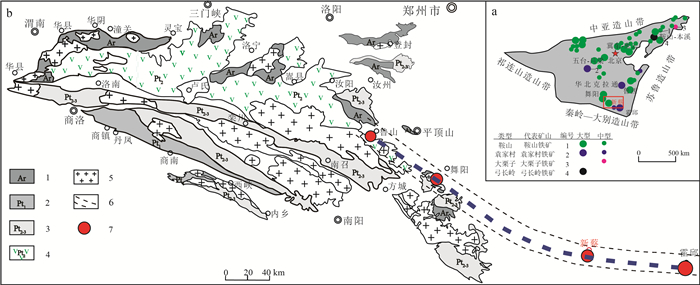
 下载:
下载:

